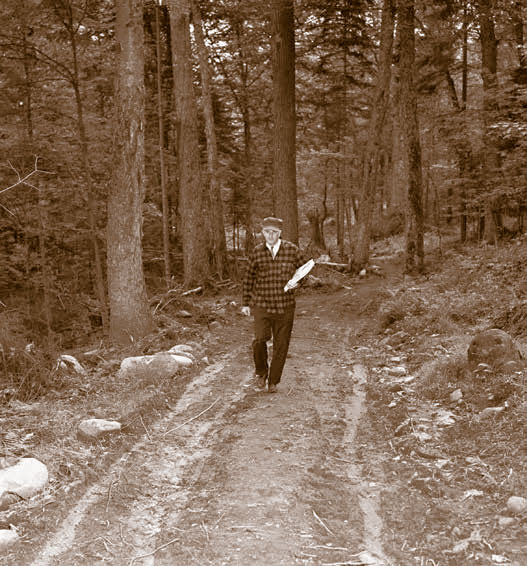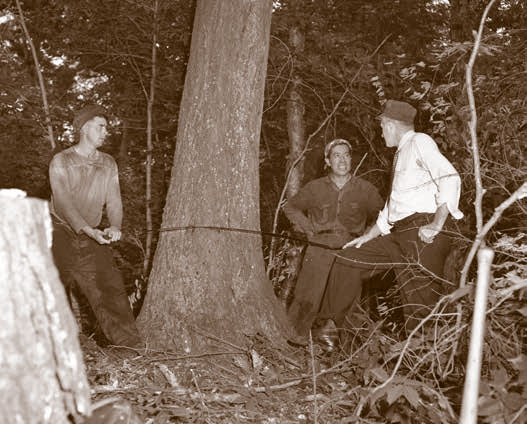In the spring of 1917, about 60 camps operated in Reverend Frank A. Reed’s area.



An article printed in “The Northern Logger “, December 2022
In the spring of 1917, about 60 camps operated in Reverend Frank A. Reed’s area. Spruce was the major wood used in the manufacturing of paper at the time. Some balsam fir and hemlock could be used in the process. The trees could be felled during the period of sap flow from about May 15 to August 15. With approximately 3,000 men employed, the felling was done by two men with a cross-cut saw. They trimmed and peeled the trees and left them on the ground for skidding later in the season.
What follows is one of Rev. Reed’s earliest memories of his long ministerial career.
I decided to start my camp visitation programs as soon as the felling season started in the camps. My first trip to the Gould Paper Company camps led up the south branch of the Moose River. The first stop was a camp operated by Henry Hoe of Moose River on the north side of the river and about 15 miles from McKeever. James Canan had two big camps a little farther up the south side of the river with Joe Gordon and a man named Gardiner as the foreman.
Mr. and Mrs. Louis Holland of Lowville and Ed Wheeler were the cooks in these camps. Clinton and Walter Thompson of Beaver River had a sub job for James Canan near Stink Lake Mountain, and their mother was the cook in their camp.
I went from their camp to visit two camps on North Lake run by Doug Purcell and Frank Murphy for the Gould Paper Company. There I also met Rev. Byron-Curtiss, who lived at North Lake and ran the supply boat with a partner. He was the author of the well-known book The Life and Adventures of Nat Foster: Trapper and Hunter of the Adirondacks.
From there, I hiked from North Lake to Rock Dam on the Moose River and cross the river to the camp of Lewis Joslin and Ward King; both of them lived in Boonville. I found the men hospitable and friendly on these visits and attentive at the worship service held in the bunkhouses. I found that my pack was not big enough for traveling items and a supply of New Testament gospels for the men. Magazines for the men could be sent in with the tote teams.
From Lewis Joslin’s camp on the Red River, I hiked on the dirt road to Limekiln Lake and then on the highway to Inlet. This trip had been a hike of about 100 miles through the woods from McKeever.
Barnes and McGuire of Boonville had a good-sized crew of lumberjacks, mostly from the Black River area housed in a house in Inlet. They were cutting spruce around Eagle Bay. Ezra Barnes was in charge of the operation on this job, Mrs. Barnes was the cook, and their daughter Harriett was her assistant.
The Clearwater (a steamer that ran from the head of Fourth Lake to Old Forge) hadn’t started running on the Fulton Chain lakes yet, so I hiked from Inlet to Fulton Chain (now Thendara) on the dirt road (now Route 28). A man overtook me by automobile and asked me if I wanted a ride. He turned out to be a wholesale grocery man from Corning, New York which was 12 miles from my old home. Reed’s remembrance of his first experience after joining the staff of the Adirondack Lumber Camp Parish in the fall of 1916 is a modest account of a journey by foot through the heavily forested central Adirondack region. Today’s loggers who are familiar with the young reverend’s route know the severe conditions he must have endured to bring the Gospel to the lumber camps.
In 1917, McKeever was a thriving village with a pulp mill operated by the Iroquois Paper Company and a hardwood sawmill. “Former (New York State) Governor John A. Dix was active in the leadership of both mills,” Reed remembered. He often said, “McKeever was an excellent place for on-the-spot training.”
William J. O’Hern is the author of several books on the history of logging in the Adirondacks and Rev. Frank A. Reed, including Adirondack Logging: Life and Times in the Early Years of Logging’s Mechanization.

